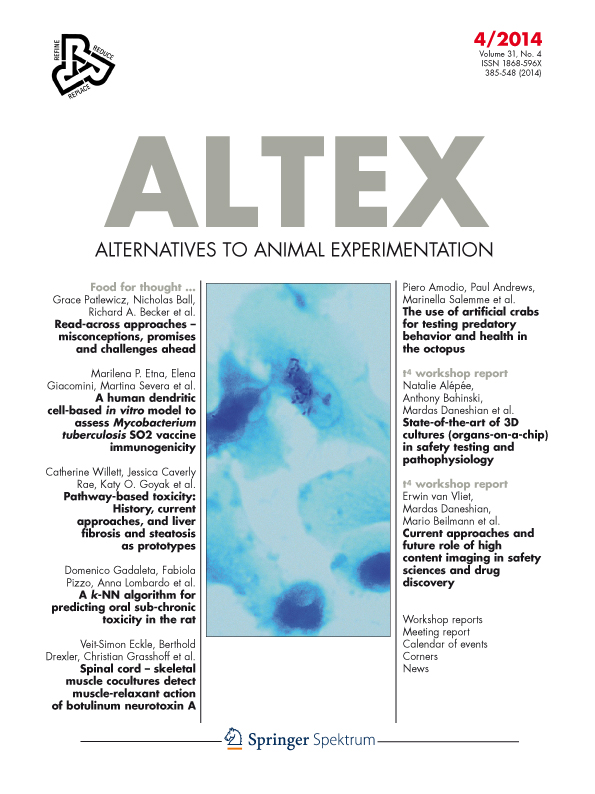Natalie Alépée
L’Oréal R&I, Aulnay, France
Anthony Bahinski
Wyss Institute for Biologically Inspired Engineering, Harvard University, Boston, USA
Mardas Daneshian
Center for Alternatives to Animal Testing – Europe (CAAT-Europe), University of Konstanz, Konstanz, Germany
Bart De Wever
The Alexandra Association, Monaco
Ellen Fritsche
Leibniz Research Institute for Environmental Medicine, Duesseldorf, Germany
Alan Goldberg
Center for Alternatives to Animal Testing (CAAT), Johns Hopkins University, Bloomberg School of Public Health, Baltimore, USA
Jan Hansmann
Department of Tissue Engineering and Regenerative Medicine, University Hospital Wuerzburg, Wuerzburg, Germany
Thomas Hartung
Center for Alternatives to Animal Testing – Europe (CAAT-Europe), University of Konstanz, Konstanz, Germany; Center for Alternatives to Animal Testing (CAAT), Johns Hopkins University, Bloomberg School of Public Health, Baltimore, USA
John Haycock
Department of Materials Science of Engineering, University of Sheffield, Sheffield, UK
Helena T. Hogberg
Center for Alternatives to Animal Testing (CAAT), Johns Hopkins University, Bloomberg School of Public Health, Baltimore, USA
Lisa Hoelting
Doerenkamp-Zbinden Chair of in vitro Toxicology and Biomedicine, University of Konstanz, Konstanz, Germany
Jens M. Kelm
InSphero AG, Schlieren, Switzerland
Suzanne Kadereit
Doerenkamp-Zbinden Chair of in vitro Toxicology and Biomedicine, University of Konstanz, Konstanz, Germany
Emily McVey
Board for the Authorization of Plant Protection Products and Biocides, Wageningen, The Netherlands
Robert Landsiedel
BASF SE, Experimental Toxicology and Ecology, Ludwigshafen, Germany
Marcel Leist
Center for Alternatives to Animal Testing – Europe (CAAT-Europe), University of Konstanz, Konstanz, Germany; Doerenkamp-Zbinden Chair of in vitro Toxicology and Biomedicine, University of Konstanz, Konstanz, Germany
Marc Lübberstedt
Bioreactor Group, Berlin-Brandenburg Center for Regenerative Therapies (BCRT), Charité Campus Virchow-Klinikum, Berlin, Germany
Fozia Noor
Biochemical Engineering, Saarland University, Saarbruecken, Germany
Christian Pellevoisin
L’Oréal R&I, Aulnay, France
Dirk Petersohn
Henkel AG & Co KGaA, Duesseldorf, Germany
Uwe Pfannenbecker
Beiersdorf AG, Hamburg, Germany
Kerstin Reisinger
Henkel AG & Co KGaA, Duesseldorf, Germany
Tzutzuy Ramirez
BASF Aktiengesellschaft, Experimental Toxicology and Ecology, Ludwigshafen, Germany
Barbara Rothen-Rutishauser
Adolphe Merkle Institute, University of Fribourg, Switzerland
Monika Schäfer-Korting
Institute for Pharmacy (Pharmacology and Toxicology), Freie Universität Berlin, Berlin, Germany
Katrin Zeilinger
Bioreactor Group, Berlin-Brandenburg Center for Regenerative Therapies (BCRT), Charité Campus Virchow-Klinikum, Berlin, Germany
Marie-Gabriele Zurich
Department of Physiology, Faculty of Biology and Medicine, University of Lausanne, Lausanne, Switzerland; Swiss Center for Applied Human Toxicology (SCAHT), University of Lausanne, Lausanne, Switzerland
[hide affiliations]
Abstract
Integrated approaches using different in vitro methods in combination with bioinformatics can (i) increase the success rate and speed of drug development; (ii) improve the accuracy of toxicological risk assessment; and (iii) increase our understanding of disease. Three-dimensional (3D) cell culture models are important building blocks of this strategy which has emerged during the last years. The majority of these models are organotypic, i.e., they aim to reproduce major functions of an organ or organ system. This implies in many cases that more than one cell type forms the 3D structure, and often matrix elements play an important role. This review summarizes the state of the art concerning commonalities of the different models. For instance, the theory of mass transport/metabolite exchange in 3D systems and the special analytical requirements for test endpoints in organotypic cultures are discussed in detail. In the next part, 3D model systems for selected organs – liver, lung, skin, brain – are presented and characterized in dedicated chapters. Also, 3D approaches to the modeling of tumors are presented and discussed. All chapters give a historical background, illustrate the large variety of approaches, and highlight up- and downsides as well as specific requirements. Moreover, they refer to the application in disease modeling, drug discovery and safety assessment. Finally, consensus recommendations indicate a roadmap for the successful implementation of 3D models in routine screening. It is expected that the use of such models will accelerate progress by reducing error rates and wrong predictions from compound testing.


